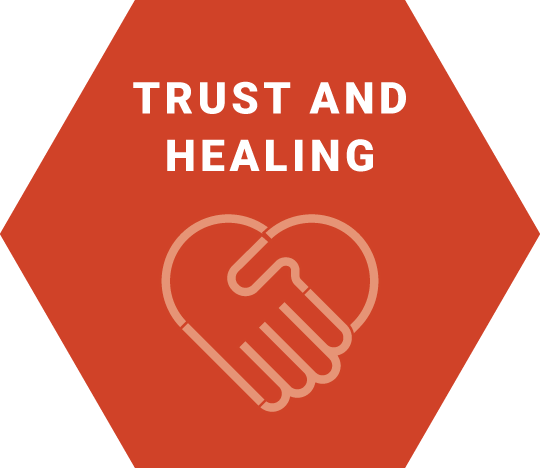| Module | Methods | Who | Where | When |
|---|---|---|---|---|
|
|
Stakeholder Analysis To identify teachers, staff, administration and external stakeholders (parents/care givers/Community Based Organizations), especially those who may be influential in building trust. |
CPS project team. | At CPS office or virtually. | Week 1 45-60 minute workshop. |
|
|
Observations To actively listen and watch stakeholders, teachers, staff, and administration to learn deeply about their day-to-day interactions. |
Students, parents, caregivers, principals, teachers, and community partners. | In schools, community locations or virtually. | Week 2 Each person should spend at least one hour observing activities or events. |
|
|
Story Circle To share stories, listen deeply, and open the floor to honest reflection. |
Students, parents, caregivers, principals, teachers, and community partners. | In schools, community locations or virtually. | Week 3 60-90 minute workshop. |
|
|
Community Commemorative Art To create a shared piece of artwork in order to reinforce the identity and connectedness of the group. |
Students, parents, caregivers, principals, teachers, and community partners. |
In schools, community locations or virtually. |
Week 4 90-120 minute workshop. |
The objective of this plan is to create a foundation of trust among different people. You will analyze the different stakeholders who need to be involved, observe these folks in their natural environments, share stories with the group to listen deeply to get a better understanding of their needs and create a shared piece of art to reinforce the group identity.
|
|
Where:At CPS Offices or virtually |
When:Week: 1 |
Supplies Needed:
|
Framing / Stakeholder Analysis
Conduct a Stakeholder Analysis with the CPS Core Project Team in order to identify which teachers, staff, administration and external stakeholders (parents/care gives/CBOs), especially those who may be most distrustful or influential in building trust, will need to be engaged in order to create trust.
- Define the scope for the exercise.
- Generate a broad list of stakeholders who are involved or impacted in your problem frame.
- Capture each specific stakeholder on a separate sticky note.
- Transfer your sticky notes to a physical or virtual whiteboard.
- Organize them in a way that tells a story. This can show a process, or radiate out from a central stakeholder.
- Use visual cues such as color, arrows, circles and lines to show relationships and connections between stakeholders.
- Look for and fill in any gaps with impacted stakeholders you may have missed in your map.
- Prioritize your stakeholders.
- Each person votes for the 3-5 most critical stakeholders relative to your stated objective.
- Transfer the 10-20 stakeholders with the most votes to a 2 x 2 prioritization matrix.
- Force rank the stakeholders across the X axis based on how impacted they are by the problem. Your 10-20 stickies should be in a straight line, evenly distributed across the X axis.
- Force rank the stakeholder across the Y axis based on how influential they might be.
- Name each quadrant in the context of the problem you are exploring.
- Circle the top priority stakeholders based on what you want to do next.
|
Who:
|
Where:In schools, community setting or virtually |
When:Week: 2 |
Supplies Needed:
|
Listening / Observations
To observe folks in the school community such as parents/caregivers, teachers, students or community members in any natural environment to get a sense of their day-to-day experience so a foundation of trust can be built.
- Identify what and/or who you will observe.
- Obtain any necessary permissions for attendance, recording video or photographs.
- Align as a team on the theme or scope of your observation session.
- Prepare the Observations worksheet.
- Attend the event/session/meeting and take detailed notes of what you see.
- If applicable, put other attendees at ease by introducing yourself and state the goal of your observation.
- Be a fly on the wall and do your best not to stand out.
- Record the activities going on around you.
- Record detailed descriptions or drawings about the environment.
- Capture the interactions you witness between people.
- Write down the objects people are using and how they are using them.
- Identify any other users. Write down the role they are playing and what they are doing.
- Capture photographs or sketches of things that look out of the ordinary or surprise you.
- Debrief with your team immediately after the session to discuss what you saw. This will help you start identifying themes and patterns.
|
|
Where:In schools, community locations or virtually |
When:60-90 minute workshop |
Supplies Needed:
|
Trust and Healing / Story Circle
Facilitate one or two story circles with a mixed group of parents/caregivers, principals, teachers and community partners in order to listen deeply to understand others’ experiences with the goal of creating a foundation of trust among the different groups.
- Determine who should attend the Story Circle.
- Decide on a lead facilitator and note taker.
- Prepare any materials you will need during the session.
- Arrange the setup of the physical or virtual space.
- Maintain an arrival cut-off time. Late comers may not participate.
- Ask everyone to put everything away, silence all cell phones, and take everything off their lap.
- Welcome the group and introduce yourself.
- Ask if your team may take notes on the discussion to record ideas.
- Spend 5 minutes establishing community agreements.
- Share the background of Storytelling circles.
- Give instructions to invite people to share a story that lasts about 3-5 minutes in response to a prompt.
- Indicate that you will pass around a voice recorder giving each person the option to record, or not.
- Instruct each person to pass the recorder to the person on their left to speak.
- Each person is allowed to pass on their turn if they choose.
- Introduce guidelines for story telling before beginning.
- Ask if anyone has questions before beginning.
- After the initial pass of the circle, go around again to invite those who passed to share.
- Facilitate an open dialogue about key ideas, phrases and learnings once everyone who wants to has shared a story.
- Wrap up by thanking them and acknowledging their participation. Share any next steps.
- Follow up on any commitments you made during next steps.
|
Who:
|
Where:In schools, community locations or virtually |
When:90-120 minute workshop |
Supplies Needed:
|
Trust and Healing / Community Commemorative Art
Facilitate a community commemorative art session with a mix of parents, students, principals, teachers and community members (up to 30 in one session) in order to reinforce the identity and connectedness of the group. For example, if the community is aiming to identify a new community garden for the school, the art session could focus on each participant sharing a flower they think represents the school community.
- Choose your topic and purpose of the session.
- Gather your materials.
- Choose and invite participants to your session. Include the pre-work exercise in your invitation.
- Before your session, organize all props on an easily accessible table in the front or middle of the room.
- Arrange the room to accommodate groups of 3 or more per table, and provide basic supplies such as scissors and glue on each table.
- Once everyone arrives, thank them for coming and introduce the activity.
- Pass out a title and caption cards to each person.
- Each person spends 20 minutes making their artifact using the provided materials.
- While the participants are creating their art pieces, walk around and listen to conversations. Take note of what you see and hear.
- Invite volunteers to share their art with the group, highlighting their title, caption and explain what their art means to them and how it answers the prompt.
- Discuss as a group any collective learnings, feelings or stories that are emerging.
- As a group, decide on a title that represents their collection of art, stories and expressed values.
- At the end, agree as a group the ideal place to display this art collection.
- Show participants where they can find other community art projects (if applicable).
- Share how they can stay involved in future discussions.
- Install or upload the art project as agreed, and send a notification to the participants so that they can view their collective community commemorative art.



